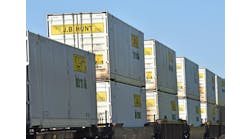In the wake of Hurricane Katrina, the Mississippi River is now open in both directions to ships with a draft of 35 feet during daylight hours. Now that a route has been re-established to the Port of New Orleans and other ports on the lower Mississippi River, the port is bringing together all of the pieces that will allow it to be a major force in the reconstruction of New Orleans. The Port headquarters building now has power, and the Louisiana State Police SWAT team has opened a temporary headquarters on the first floor.
"The Port of New Orleans' riverfront terminals survived Hurricane Katrina in fairly decent shape," says Gary LaGrange, port president and CEO. "Although they are damaged, they are still workable once electrical power and manpower is available. In the next several weeks, almost all of the Port of New Orleans will be dedicated to military relief vessels. In the next week to two weeks, commercial vessels will return once electrical power and manpower arrive.”
LaGrange adds that many repairs will be needed to bring the Port back to full capacity. Cargo containers have been tossed around at the Napoleon Avenue Container Terminal and the Nashville Avenue Complex and remain strewn about.
Two gantry cranes at the Napoleon and Nashville Avenue Complexes are expected to have damage to electronic components. The other two gantry cranes at Napoleon/Nashville are expected to work once they have electric power. The U.S. Department of Transportation's Maritime Administration (MARAD) is working to supply the cranes with power through huge generators.
As of 4 p.m. Sunday, (September 4, 2005), about 15 ships passed by the Port of New Orleans on their way to upriver ports such as the Port of South Louisiana and the Port of Baton Rouge. All three river pilot groups on the lower Mississippi River recommend opening the river to two-way traffic.
The Mississippi River-Gulf Outlet (MRGO), an alternate route for the Mississippi River, is open to 9 feet of draft. It could be opened to 27 feet of draft once debris is removed from the channel. The conditions of the terminals along the MRGO and the Industrial Canal are unknown except that they have no electrical power and they are severely flooded.
The U.S. Department of Transportation's Maritime Administration is following up on a request by the Port of New Orleans for help. They are providing several ships with the capacity to temporarily house 1,000 people who will operate the port. Those 1,000 people will be either essential Port of New Orleans employees or crews working ships at the Port of New Orleans. Some of the ships will be outfitted with generators needed to supply the power needed for port operations.
LaGrange also says the Port is in dire need of diesel fuel, and is trying to procure it from FEMA. The Port has procured transportation for the fuel through MARAD. MARAD has told the port that it would strongly consider deploying its ship, the Potomac, from Beaumont, Texas, to New Orleans if FEMA provided the fuel.
The Port of New Orleans is in contact with the state’s Homeland Security staff in order to make a formal request from FEMA.
The diesel is needed to run ship-board generators that will create the electricity to run Port operations. Those Port operations are going to be crucial to getting supplies and aid to New Orleans in the coming days.
www.portno.com
www.fema.gov
www.marad.dot.gov
Latest from Transportation & Distribution


